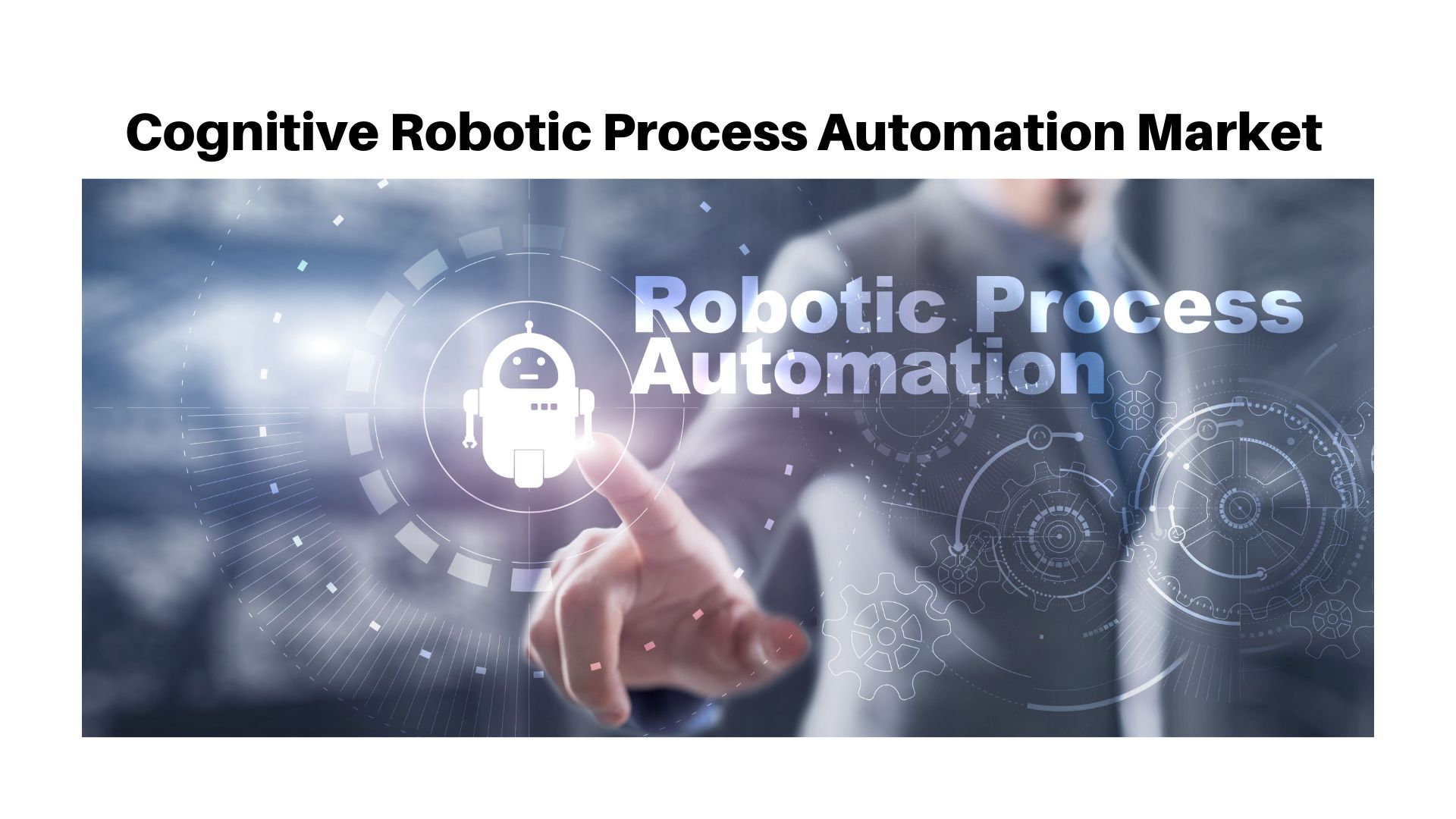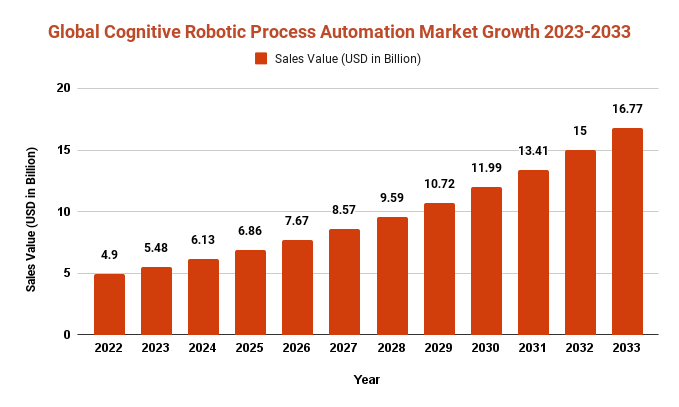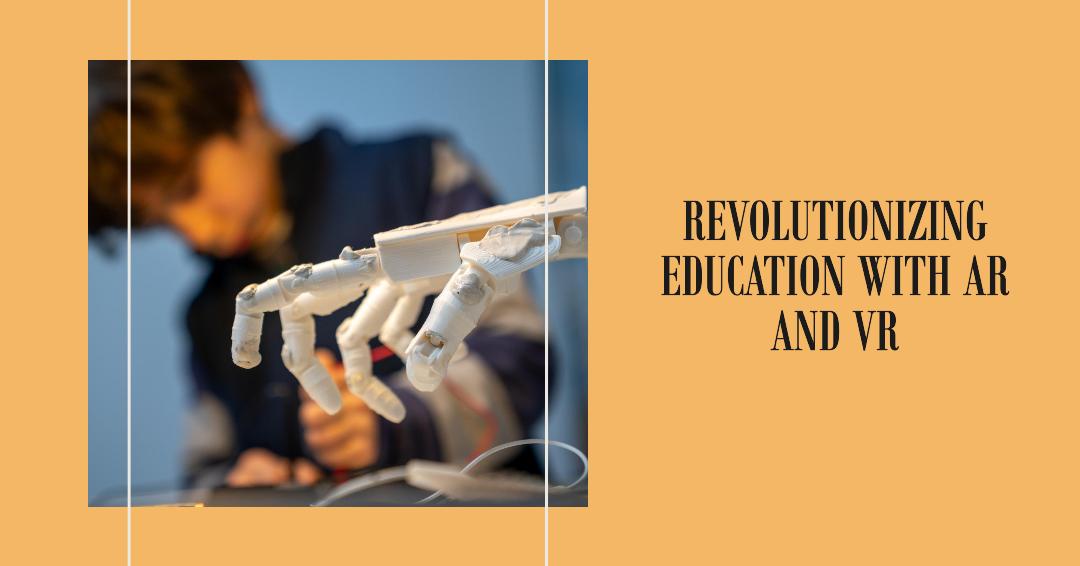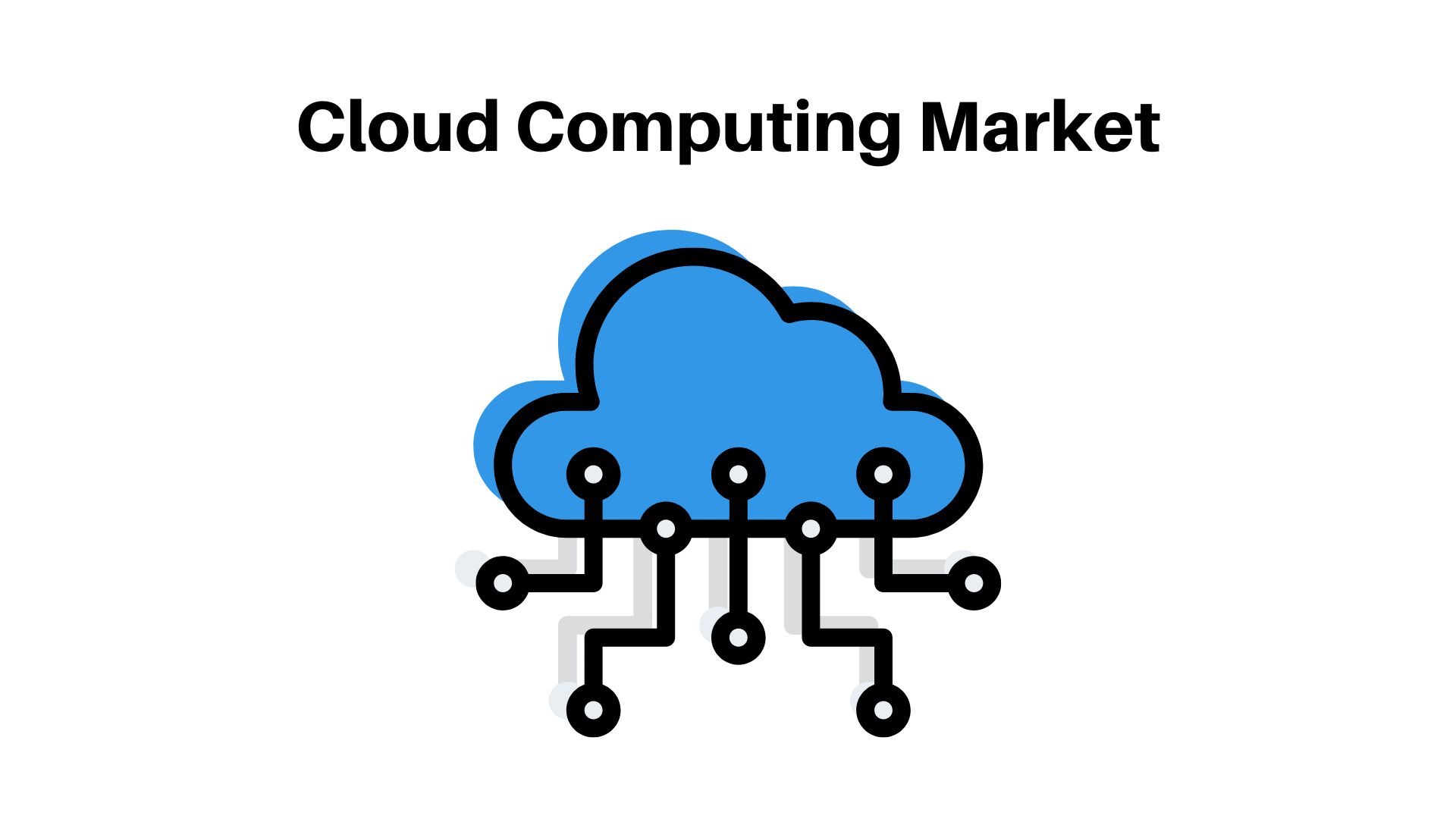Cognitive Robotic Process Automation Market size is expected to reach USD 16.77 Bn by 2033

Page Contents
Market Overview
Published Via 11Press: Cognitive Robotic Process Automation Market is an emerging technology that combines elements of artificial intelligence (AI) and robotic process automation (RPA), in order to automate repetitive rule-based tasks that were once carried out manually by humans. CRPA systems use machine learning algorithms for learning from large datasets and making decisions based on this information; as well as natural language processing technologies (NLP), which understand and interpret human speech. Cognitive RPA systems differ significantly from their traditional RPA counterparts in that they can complete more complex tasks that require higher cognitive ability, such as reading emails, invoices and customer service tickets in order to understand unstructured data before applying it to make decisions or take appropriate actions.
The Cognitive Robotic Process Automation Market size is expected to reach USD 16.77 Bn by 2033, up from its current value of USD 4.9 Bn in 2022, growing at an annual compound growth rate (CAGR) of 11.83% from 2023-2033.
CRPA can be applied across industries ranging from finance and healthcare, to customer service and beyond. Financial institutions could utilize it for automating loan applications while healthcare providers use it for scheduling appointments automatically and reminding patients about appointments. Implementing CRPA can bring many advantages to organizations, including improved efficiency, decreased errors, cost savings and employee liberation. Implementation must be carefully considered so as to align it with an organization's values and goals and to be used ethically.
Key Takeaways
- CRPA combines elements of AI and RPA to automate more complex tasks that require higher cognitive abilities.
- CRPA systems employ machine learning algorithms to gain insight from large datasets and make decisions based on that information, while natural language processing (NLP) helps analyze human speech.
- CRPA technology can be applied across various industries, from finance and healthcare to customer service and service delivery.
- Benefits of CRPA include increased efficiency, decreased errors and cost savings as well as freeing up employees to focus on more advanced tasks requiring human creativity and problem-solving abilities.
- Implementing CRPA requires careful thought and planning in order to align it with an organization's goals and values, and ensure it is used ethically and responsibly.
- CRPA is an emerging technology with significant implications for how organizations will operate over the coming years.

Request Sample Copy of Cognitive Robotic Process Automation Market Report at: https://marketresearch.biz/report/cognitive-robotic-process-automation-market/request-sample/
Regional Snapshot
- North America: North American market for CRPA is projected to lead the global industry due to the presence of key solution providers, such as UiPath, Automation Anywhere, and Blue Prism. The United States stands out as a particularly large adopter of CRPA solutions across numerous industries such as BFSI, healthcare and manufacturing.
- Europe: The European CRPA market is poised for significant expansion due to growing industry demands for automation and digital transformation. United Kingdom, Germany and France are three key markets for CRPA products within Europe.
- Asia Pacific: The Asia Pacific CRPA market is projected to experience the highest compound annual compound annual compound growth over its forecast period due to rising adoption of automation technologies and presence of emerging economies such as China and India. Furthermore, demand is likely to increase across industries including banking, financial services and insurance (BFSI), healthcare and retail.
- Latin America: The CRPA market in Latin America is projected to experience tremendous growth due to the growing use of automation technologies across industries like BFSI, healthcare and manufacturing. Brazil and Mexico are two key CRPA markets within Latin America.
- Middle East and Africa: The Middle East and Africa CRPA market is projected to experience significant growth, due to the increasing adoption of automation technologies and digital transformation initiatives across various industries. United Arab Emirates and Saudi Arabia are considered major markets for CRPA in this region.
Drivers
There are multiple drivers causing the rise of Cognitive Robotic Process Automation (CRPA), including:
- Increased Demand for Automation: With organizations striving to streamline operations, reduce costs, and maximize efficiency, automation technologies like CRPA have seen increased popularity.
- Need for Digital Transformation: With the growing use of digital technologies across industries, organizations must adapt their processes in order to keep pace with an ever-evolving business environment. CRPA provides organizations with assistance for making this transformation possible by automating complex tasks and expediting decision-making processes.
- Access to advanced technologies: Thanks to advances in artificial intelligence (AI) and natural language processing (NLP), more sophisticated CRPA solutions have emerged that automate tasks that were once performed manually by humans.
- Rising labor costs: As labor costs continue to escalate around the globe, organizations face greater difficulty finding and keeping employees to perform repetitive tasks. With CRPA automation systems available today, businesses can reduce these expenses significantly by automating these repetitive processes.
- Increased regulatory Compliance: With an ever-increasing list of regulations and compliance requirements across industries, CRPA can assist organizations in meeting them through automating tasks like data entry and record keeping.
- Enhancing customer experience: CRPA can assist organizations in improving the customer experience through faster response times and personalized interactions, ultimately leading to greater customer satisfaction and loyalty.
Restraints
Cognitive Robotic Process Automation (CRPA) growth can be driven by several drivers; however, some obstacles could impede its adoption and growth such as:
- Lack of Awareness and Understanding: In some organizations, organizations may be unaware of the possible benefits of CRPA or have insufficient understanding about its workings; as a result, it may be challenging for them to accurately assess its potential impacts and make informed decisions regarding its adoption.
- Resistance to Change: Some employees may view CRPA adoption as an unnecessary threat to their jobs, creating resistance within organizations and making implementation of CRPA solutions challenging.
- Integration Challenges: Integrating CRPA solutions into existing IT systems can be complex, requiring substantial investments in IT infrastructure and resources to successfully do so.
- Ethical and legal Considerations: As CRPA solutions become more advanced and autonomous, organizations will need to carefully consider ethical and legal considerations such as data privacy, transparency and accountability when using them responsibly. Organizations must carefully consider these issues so their use of CRPA remains ethical and responsible.
- Technical Limits: While CRPA solutions continue to advance, they still possess technical constraints which restrict their ability to handle complex tasks or make complex decisions, thus limiting their utility in certain industries or applications.
Opportunities
- Expansion into New Industries: Although CRPA has gained acceptance across industries such as banking, healthcare, and manufacturing, its use may also extend into retail, transportation and logistics environments.
- Integration with Emerging Technologies: Combining CRPA with emerging technologies like blockchain, IoT and machine learning offers opportunities to create more sophisticated automation solutions that can drive greater efficiency and innovation.
- Customization and personalization: Customizing and personalizing CRPA solutions to suit the specific needs of individual organizations can allow them to tailor automation solutions specifically to their own business processes and increase effectiveness.
- Cloud-Based Solutions: There may be opportunities to provide cloud-based CRPA solutions that are more easily scaled and deployed across organizations, which could allow organizations to adopt automation technologies more quickly and cost effectively.
- Enhance Analytics and Reporting Capabilities: CRPA solutions generate vast quantities of data that can be leveraged to drive insights and inform decisions. There may be opportunities to expand analytics and reporting capabilities so organizations can reap maximum value from their automation solutions.
- As CRPA solutions become more complex, there may be opportunities to enhance user interfaces to make them more user-friendly and intuitive. This could increase adoption as well as user satisfaction.
Challenges
Cognitive Robotic Process Automation (CRPA) faces numerous barriers that could impede its adoption and effectiveness, such as:
- Implementation can be time-consuming and complex: Implementing CRPA solutions is often complex and time-consuming due to needing to alter existing processes and IT systems significantly, making it challenging for organizations to adopt it quickly and efficiently.
- Data Quality and Availability: CRPA solutions depend on high-quality data in order to operate effectively; unfortunately, many organizations struggle with poor data quality and incompleteness issues that limit their solutions' efficacy.
- Security and Privacy Issues: CRPA solutions deal with sensitive data and perform crucial tasks, raising security and privacy concerns for organizations. Organizations should make sure that their CRPA solutions comply with all relevant regulations for maximum peace of mind.
- Lack of Talent: Implementing and deploying CRPA solutions requires highly specialized knowledge such as data science, machine learning and software engineering – unfortunately these areas often suffer from an acute talent deficit that makes CRPA deployment challenging for organizations.
- Cultural Resistance: Continuous Risk Protection and Analysis can create cultural resistance within organizations, with employees perhaps being resistant to change; it may take some time before employees fully support and adopt solutions offered through CRPA.
- Initial Investment Costs: Adopting CRPA solutions often involves significant initial investments such as software licenses, hardware purchases and IT infrastructure upgrades – this can present an obstacle to adoption for organizations with limited budgets.
Market Segmentation
End User
- Retail
- Transportation
- BFSI
- Healthcare
- Manufacturing
- IT & Telecom
- Others
product
- Model-Based Robotics
- Model-Free Robotics
components
- Hardware
- Software
- Service
Key Players
- Blue Prism
- IPsoft Inc.
- NICE Systems Ltd.
- Automation Anywhere Inc.
- Verint System Inc.
- UiPath
- WorkFusion
- Pegasystems Inc.
- IBM Corporation
- Arago
Report Scope
| Report Attribute | Details |
| Market size value in 2022 | USD 4.9 Bn |
| Revenue forecast by 2033 | USD 16.77 Bn |
| Growth Rate | CAGR Of 11.83% |
| Regions Covered | North America, Europe, Asia Pacific, Latin America, and Middle East & Africa, and Rest of the World |
| Historical Years | 2017-2022 |
| Base Year | 2022 |
| Estimated Year | 2023 |
| Short-Term Projection Year | 2028 |
| Long-Term Projected Year | 2033 |
Recent Developments
- Natural Language Processing (NLP) and Chatbots: As Cognitive RPA becomes more sophisticated in its ability to interpret natural language and interact with humans, its capacity for NLP and chatbot development increases, creating virtual assistants which can carry out customer service or sales tasks more efficiently than ever.
- Machine Learning and Artificial Intelligence: With advances in machine learning and AI, cognitive RPA is now capable of learning from data to adapt to new situations more efficiently and accurately, enabling more accurate task automation.
- Predictive Analytics: Cognitive RPA has become an effective way for businesses to use predictive analytics, providing valuable insight and allowing for informed decisions based on data analysis.
- Cognitive Document Automation: Cognitive RPA can be used to automate document processing tasks such as data extraction, classification and validation – this feature is especially beneficial in industries like finance and healthcare where large volumes of data must be handled.
- Hyperautomation: Hyperautomation involves employing advanced technologies like AI, machine learning and RPA to automate complex business processes from beginning to end. Cognitive RPA plays an essential part of this approach as it allows businesses to automate processes that involve cognitive tasks such as decision making.
Key Questions
Here are some frequently asked questions and their responses about cognitive robotic process automation (CPA):
Q: What Is Cognitive Robotic Process Automation (RPA)?
A: Cognitive RPA refers to the combination of artificial intelligence (AI), machine learning, and natural language processing (NLP) technologies with traditional RPA tools to automate complex and data-intensive tasks.
Q: How is Cognitive RPA different from Traditional RPA?
A: While traditional RPA uses rule-based automation of repetitive tasks with software robots, Cognitive RPA takes an advanced approach by employing AI, machine learning and NLP technologies to automate complex tasks which involve decision-making, reasoning and analysis.
Q: What applications of Cognitive RPA exist?
A: Cognitive RPA has many uses, such as chatbots and virtual assistants for customer service and sales, document automation, predictive analytics, and hyperautomation.
Q: What are the Benefits of Cognitive RPA?
A: Cognitive RPA offers numerous advantages, such as increased efficiency, decreased errors and increased accuracy with faster processing times – as well as freeing up employees to focus on higher value tasks.
Q: What are the Challenges Associated with Implementing Cognitive RPA?
A: Implementing Cognitive RPA can present numerous obstacles, including data quality issues, needing specific skills such as data science or AI expertise, job displacement or workforce retraining concerns as well as workforce recruitment needs.
Q: How can businesses get started with Cognitive RPA?
A: Businesses can start by identifying processes suitable for automation, researching available tools and technologies, and devising an implementation roadmap which includes training and upskilling employees. Furthermore, it's crucial that they understand both potential benefits and challenges associated with Cognitive RPA implementation.
Contact us
Contact Person: Mr. Lawrence John
Marketresearch.Biz (Powered By Prudour Pvt. Ltd.)
Tel: +1 (347) 796-4335
Send Email: [email protected]
The team behind market.us, marketresearch.biz, market.biz and more. Our purpose is to keep our customers ahead of the game with regard to the markets. They may fluctuate up or down, but we will help you to stay ahead of the curve in these market fluctuations. Our consistent growth and ability to deliver in-depth analyses and market insight has engaged genuine market players. They have faith in us to offer the data and information they require to make balanced and decisive marketing decisions.



